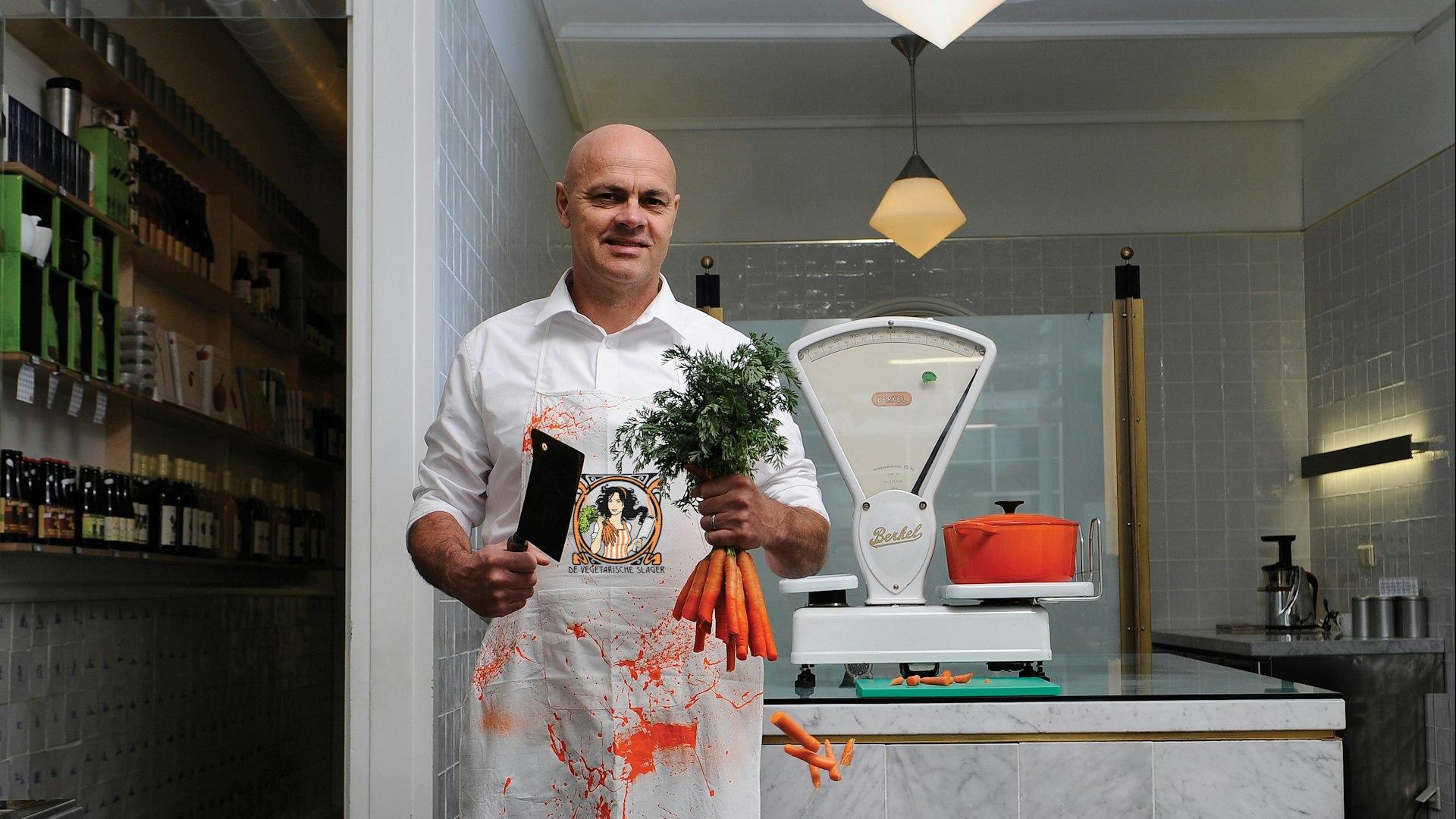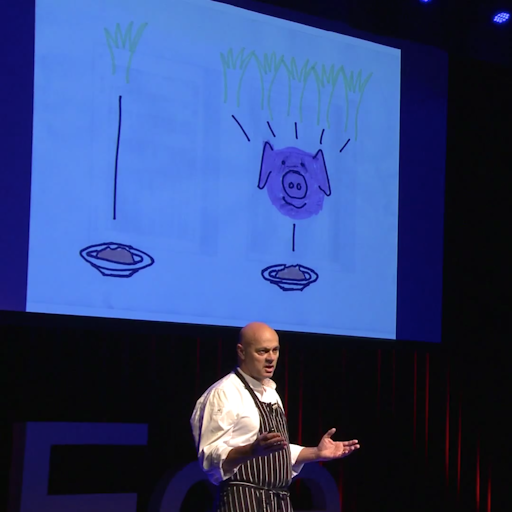Time to butcher these 5 myths about fake meat
And maybe these facts will bring meat eaters and vegetarians closer together again.
Klicke hier für die deutsche Version.
After boycotting McDonald’s for 20+ years I had to try the new #mcvegan. And then there were #cinnamonrolls at the uni. Both really good. So hard being vegan, have to eat all the time 😂 🍔🍩🍟🍰🍕🍦
Such was one of the numerous
McVegan at McDonald’s, tofu curried sausage at Aldi and vegetarian cold cuts from Rügenwalder – replacement products for a
1. »It doesn’t taste like anything!«
»You can explore culinary culture all over the world and you will find the popular dishes always contain the same 2 ingredients.«
Co-founder of

Their scents and tastes – especially the grill aroma – have been triggering reactions in our brains since time immemorial, and they tell us to tuck in! In order to create the same reaction with plant-based foods, it’s imperative to get the consistency and the taste right.
In the case of the first, researchers at the University of Wageningen in the Netherlands made a The grill aroma has been triggering reactions in our brains since time immemorial, and they tell us to tuck in!
Their Shear Cell Technology turns beans, peas and lentils into steaks, which in terms of structure are hard to differentiate from a real T-bone steak. The next phase of development is
Simultaneously, customers taking part in blind tastings thought plant-based burgers served by US companies
Conclusion: Plants can replicate the components that make meat so irresistible.
2. »It’s unhealthy!«
One of the leading ingredients in most replacement products is soy. The bean contains a lot of

Often, however, on the ingredient list soy is being followed by a long list of additives including spices, flavourings and colourings – just like with most convenience products. It is common knowledge that they contain less nutrients than fresh products and a lot of salt and sugar. In that aspect, it makes little difference whether they contain meat or carry a green »vegan« label.
Protein-rich soy is a special case anyways, when it comes to health matters: For almost 70 years scientists have been discussing whether soy is rather healthy for humans or not. One of the most disputed issues are isoflavones, which one day protect from cancer and the other day cause it.
Of more than 6,000 women with breast cancer, those who consumed the highest volumes of soy had the greatest chance of survival.
Furthermore, soy can be processed in very different ways, for example by fermentation. That makes it even more difficult to compare scientific results and increases the need for methodically well-crafted studies. The onus then, is on studies on real people. One such milestone was
As is so often the case – and not only with nutrition – the optimal solution probably lies somewhere in the middle. In general, in the context of nutrition that means:
Conclusion: Tofu and seitan fulfil their main objective of providing us with protein in the same way as bacon and beef.
3. »Eating animals is natural!«
Consequently, tofu,
But what is »natural nutrition« anyway? A question to which Aztecs, Inuits, Neanderthals or Aborigines would all have provided different answers. For some it would have been fish, others corn, potatoes, nuts or roots. Most food we eat today didn’t start to play a part in our nutrition until the advent of farming around 10,000 years ago.
The fact is that for the majority of human history, meat did not play a key role in calorie intake.

So to argue the case for »natural nutrition« doesn’t get us very far. It leads back to the romantic notion of a »natural primitive state«, an idea that is not much older than tofu itself.To argue the case for »natural nutrition« doesn’t get us very far.
In Asia soy beans have been cultivated for more than 2,000 years, making it the oldest crop plant in the world. Tofu was created more or less at the same time. About 1,000 years later, it found its way into the kitchens of India, Japan and large parts of Asia. Seitan is thought to be some
In these countries, dishes without any animal-based ingredients aren’t labelled as »vegan«, but have an inherited place on the menus of traditional restaurants.
Tofu and meat are often found in the same dish, and why not? Both are good sources of protein, and after all, potatoes and carrots are also cooked in the same soup.
Conclusion: There is no such thing as natural nutrition. But tofu and seitan have long traditions.
4. »Rainforests are cleared for your tofu.«
This accusation is not always true, because part of the soy used in tofu production – especially organic crops – comes from southern Germany and Austria.
What is all too often true, however, is that most soy is imported from

That in itself is a case for eating more tofu, which compared to meat production, only requires a fraction of the resources to put a good portion of healthy proteins on the table. A kilo of soy could be fed to a pig, which also needs a lot of other food to develop around 500 grams of
Tofu, compared to meat production, only requires a fraction of the resources.
And because the global appetite for meat will continue to grow, forests will continue to be cleared, making a major contribution to global warming. But if more tofu was eaten than pork, the areas where soy is currently cultivated would also be sufficient in the future. And because animals don’t only eat a lot, but also produce methane gas, a single piece of steak creates
Conclusion: Soy causes problems. But there are many more hidden in meat.
5. »Much too expensive!«
Whether or not veggie sausages are too expensive, is relative. What is true, however, is that they are often more expensive than meat ones. For people who have to be very careful about how they spend their money, making the switch is barely an option.
The question is: why are meat sausages cheaper? Producing a kilo of tofu takes less time, labour and raw materials than a kilo of meat, which means the costs ought to be far lower.

That the opposite is the case has two reasons. On the one hand, the meat industry is
But that alone would not suffice to keep the price of tofu down if the meat industry were not subsidised. The most important points where public money is poured into the sausage:
- Tax: While meat, sausages and milk are considered basic foodstuffs and therefore carry a goods tax of 7%, for soy milk, the rate is the standard 19%.
- Agricultural subsidies: In 2013 the EU stumped up 240 million euros to support the expansion of livestock buildings. Meat farmers also benefit much more from the billions in agricultural subsidies because animal products require more land.
- Hidden costs: Whether in tofu or meat, consumers always cover costs that have nothing to do with the food itself. Examples are climate change adaptation or the cleaning of polluted waters. Because meat requires more resources, more of such costs arise through its production.
Conclusion: Some replacement products are actually more expensive, because they receive less funding than animal products. If all this was reflected in the price, the picture would suddenly look radically different.
This article is part of the project »The solutions lie in Germany«. In the project, »Global Ideas« by the Deutsche Welle and Perspective Daily present solutions to climate change within 3 steps, heading towards the 23rd climate change conference in Bonn in November 2017.
Step 1: »Wärmewende in Deutschland – Diese Heizung kannst du guten Gewissens voll aufdrehen« on Perspective Daily and »Smart tech propels Germany’s switch to renewables« on Global Ideas.
Step 2: »Green start-up scene – These German Start-ups will make your life easier« on Perspective Daily and »Engineering the climate — is it a good idea?« on Global Ideas.
Step 3: »Meat replacement products – Time to butcher these 5 myths about fake meat« on Perspective Daily and »Germany, land of blooming soy fields?« on Global Ideas.

Titelbild: De Vegetarische Slager - copyright




